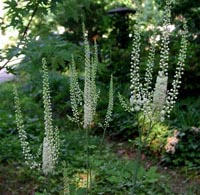Resource Library
Plant of the Week: Fairy Candles (Black Cohosh, Black Snakeroot)
The University of Arkansas System Division of Agriculture does not promote, support or recommend plants featured in "Plant of the Week." Please consult your local Extension office for plants suitable for your region.
Plant of the Week
Black Cohosh, Fairy Candles, Black Snakeroot
Latin: Cimicifuga racemosa

Most woodland wildflowers are spring bloomers, completing their life cycle before the forest is fully foliated. But one wildflower, known by a long list of common names - black cohosh, black snakeroot, bugbane or fairy candles - (Cimicifuga racemosa), blooms when the shade is at its peak. It not only grows well in the woodland garden, but it has an interesting story to tell.
Black cohosh is an herbaceous perennial with large, three-branched compound leaves emerging directly from the below-ground crown. The compound leaflets are large, dark green and deeply notched. The leaves stand about two feet tall.
When plants flower in late June or early July, the ascending, usually three-forked spike may reach 6 to 7 feet high. The white- to cream-colored flowers are individually small and crowded down the length of the spike. The true petals fall as the flower opens, leaving behind clusters of stamens that give the spike a bottle-brush look.
Plants with lots of common names usually have a long history with humankind. Black cohosh derives its name from an Algonquin name for the plant. Native Americans used the roots in a number of medicinal remedies ranging from snakebite to female ailments. Squawroot was a name sometimes applied to the plant, indicating its use for treating female distress during menstruation and menopause.
In the U.S., until recent times, medicine has been the domain of men, even the treatment of female disorders. Though the male doctors may have had lots of book learning on the subject, their lack of first-hand experience and empathy sometimes lead to treatments that went beyond the medical dictum of "first, do no harm."
Following the Civil War, one of the prescribed treatments for severe menstrual cramping was the surgical removal of healthy ovaries. That 40 percent of the patients died from the procedure because of poor sanitary conditions, makes the cure far worse than the problem. This was the medical state of affairs when one of America's first widely successful businesswoman introduced a patent medicine offering a non-surgical alternative.
The woman was Lydia Pinkham (1819-1883), a Massachusetts woman who suddenly found herself obliged to support her family after her husband lost his fortune in the economic crash of 1873. For years, she had been treating herself and female neighbors with an herbal homebrew that worked wonders on the female constitution.
These were during the days before the Food and Drug Administration, so all you had to do was promote a product heavily, and you were assured a good market. Some of these patent medicines (called such because their ingredient list was patented) worked and some didn't, but you couldn't tell by the elaborate hucksterism used to promote the products.
Lydia patented her product, Lydia Pinkham's Vegetable Compound, in 1876 and began selling it door to door for $1 a bottle. A couple years later, one of her sons had the idea of adding her picture to all promotional material, and the business took off. By the time of her death, she was selling $300,000 per year.
Another touch that improved her outreach was that she started soliciting questions from her customers. Her responses were always hand written and signed "Mrs. Pinkham." In these responses, her other pills and elixirs were shamelessly promoted. The fact that she was still writing the letters 30 years after she died didn't seem to bother her faithful customers, though one ladies' magazine printed a photo of her tombstone in 1905.
Her vegetable compound was a mixture of five herbs, all dissolved in 18 percent alcohol. If the herbs didn't cure you, the alcohol content certainly made you forget your aches and pains.
The company survived into the 1920s when it had its highest sales of $3.8 million. Her formula - minus the alcohol - is still available and manufactured by Numark Labs. As so often happens, her remedy was a much better solution to menstrual problems than that suggested by the surgeons. Modern studies now suggest that the drug interacts with serotonin receptors in the brain that regulate body temperature.
Black cohosh is a good woodland wildflower, doing best in moist, fertile but well drained sites. It's a bit gawky in the landscape when used alone, so use it in groups of three or five. It can be propagated by division or seed, which should be planted in the fall to ensure they receive their wintertime chill to aid in germination.
By: Gerald Klingaman, retired
Extension Horticulturist - Ornamentals
Extension News - July 15, 2005
The University of Arkansas System Division of Agriculture does not maintain lists of retail outlets where these plants can be purchased. Please check your local nursery or other retail outlets to ask about the availability of these plants for your growing area.